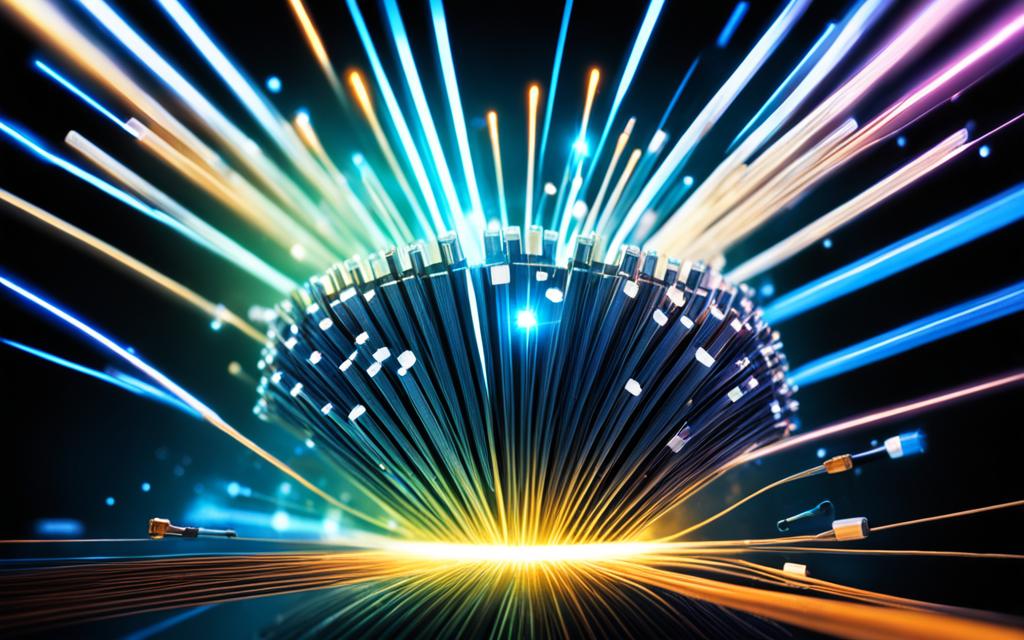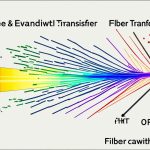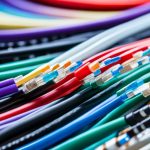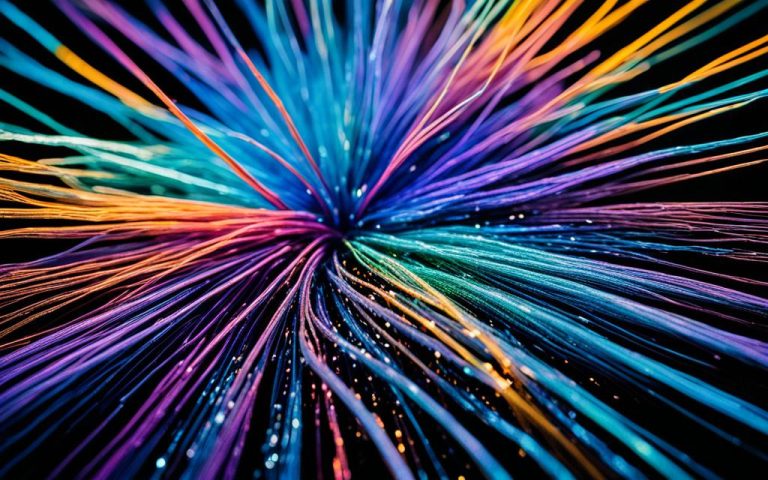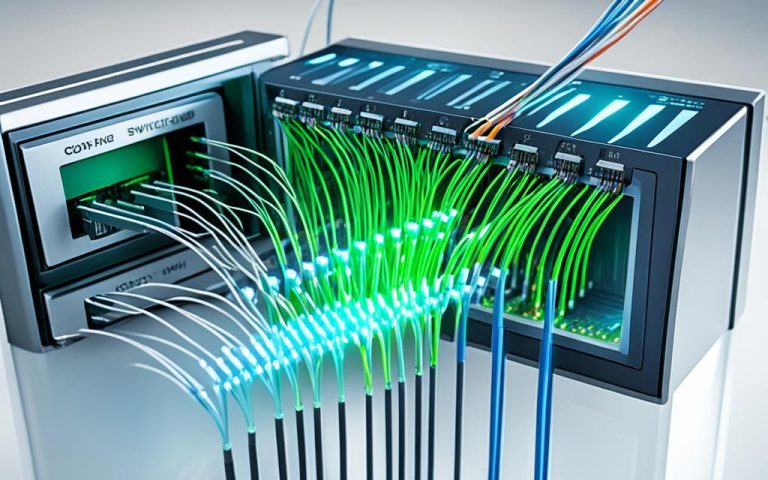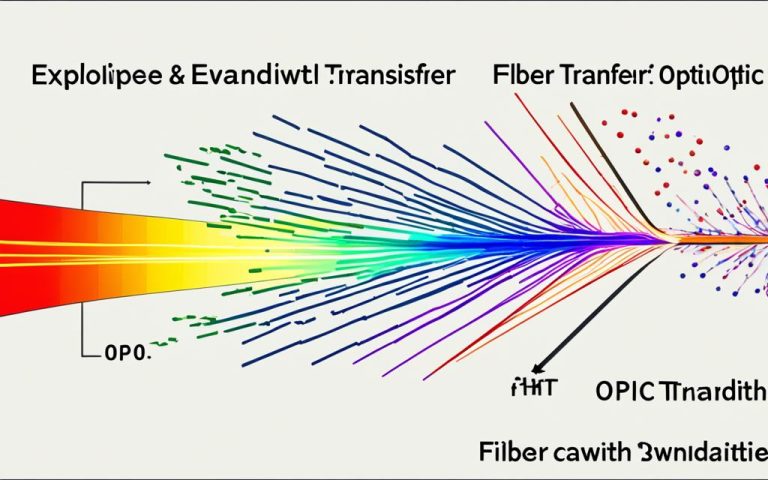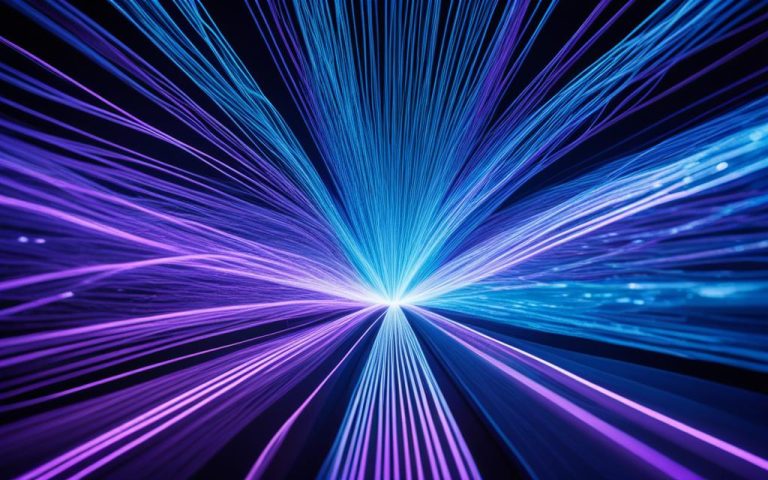Fiber optics technology has revolutionized the way we stream and deliver video content. With its ability to transmit large amounts of data over long distances at incredible speeds, fiber optics has become the backbone of video streaming, broadcasting, and video conferencing. Whether it’s high-definition (HD) or ultra-high-definition (UHD) video, fiber optic cables can carry analog and digital video signals with ease, ensuring a seamless viewing experience.
One of the key advantages of fiber optics for video streaming is its immunity to electromagnetic interference. Unlike traditional copper cables, fiber optic cables are not affected by external electrical or magnetic fields, resulting in a stable and reliable video transmission. This interference-free environment guarantees that the video quality remains pristine, free from distortions or signal loss.
Fiber Optic Video Transmission
Fiber optic video transmission offers numerous advantages, making it a preferred choice for various applications such as video conferencing, live streaming, and broadcasting. With its high capacity for data transmission and ability to deliver high-quality signals without loss of quality, fiber optic technology has revolutionized video transmission and content delivery.
One of the key advantages of fiber optic video transmission is its immunity to electromagnetic interference. Unlike traditional copper-based cables, fiber optic cables are not affected by electromagnetic signals, ensuring a stable and reliable video transmission. This makes fiber optics ideal for applications where high-quality video signals are crucial, such as surveillance systems and video walls.
Furthermore, fiber optic cables can transmit video signals over long distances without degradation. Whether it’s transmitting video content across a large campus or connecting different locations for live streaming, fiber optics can maintain the integrity of the video signals, ensuring that viewers receive a clear and consistent video experience.
To visualize the benefits of fiber optic video transmission, consider the following table comparing fiber optics with traditional copper-based cables:
| Advantages | Fiber Optic Cables | Copper-based Cables |
|---|---|---|
| High capacity for data transmission | ✓ | ✕ |
| Immunity to electromagnetic interference | ✓ | ✕ |
| Secure transmission | ✓ | ✕ |
| Ability to transmit video signals over long distances without degradation | ✓ | ✕ |
As shown in the table, fiber optic cables outperform traditional copper-based cables in several key aspects. The high capacity for data transmission, immunity to electromagnetic interference, and secure transmission make fiber optics the ideal choice for video content delivery.
In addition to the advantages mentioned above, fiber optic video transmission also offers enhanced security. Fiber optic signals are extremely difficult to tap into, providing a higher level of data privacy compared to other transmission methods. This makes fiber optics especially valuable for transmitting sensitive video content, such as confidential meetings or private video conferences.
Fiber optic video transmission has undoubtedly transformed the way video content is delivered, offering a reliable and efficient solution for transmitting high-quality video signals over long distances. With its many benefits, it is no surprise that fiber optics has become the go-to technology for video conferencing, live streaming, and broadcasting.
In the next section, we will explore the advantages of using fiber optic technology for video transmission in more detail.
Advantages of Using Fiber Optic for Video Transmission
Fiber optic technology offers numerous advantages when it comes to video transmission. Let’s explore the key benefits of using fiber optics for high-quality and reliable video delivery.
High Bandwidth Capacity
One of the significant advantages of fiber optics for video transmission is its high bandwidth capacity. Fiber optic cables can handle large amounts of data, allowing for seamless streaming of high-resolution video formats such as 4K and 8K. This ensures that viewers can enjoy crystal-clear images and immersive video experiences without any buffering or lag.
Immunity to Electromagnetic Interference
Fiber optic cables are immune to electromagnetic interference, which can degrade the quality of video signals. Unlike traditional copper cables, fiber optics can transmit video signals over long distances without any loss of quality or signal degradation. This makes fiber optics particularly suitable for applications where video transmission stability is crucial, such as live streaming events or video conferencing.
Enhanced Security
Another advantage of fiber optic technology for video transmission is its enhanced security. Fiber optic cables are difficult to tap into, making them a more secure option compared to other transmission mediums. This is especially important when transmitting sensitive video content or when ensuring the privacy of video conferences or surveillance systems.
Long-Distance Transmission Without Degradation
Fiber optics allows for video transmission over long distances without degradation of video quality. With fiber optic cables, video signals can be transmitted hundreds of kilometers without any loss of signal strength or clarity. This is particularly beneficial for applications such as video surveillance systems that require long-distance coverage while maintaining high-resolution video quality.
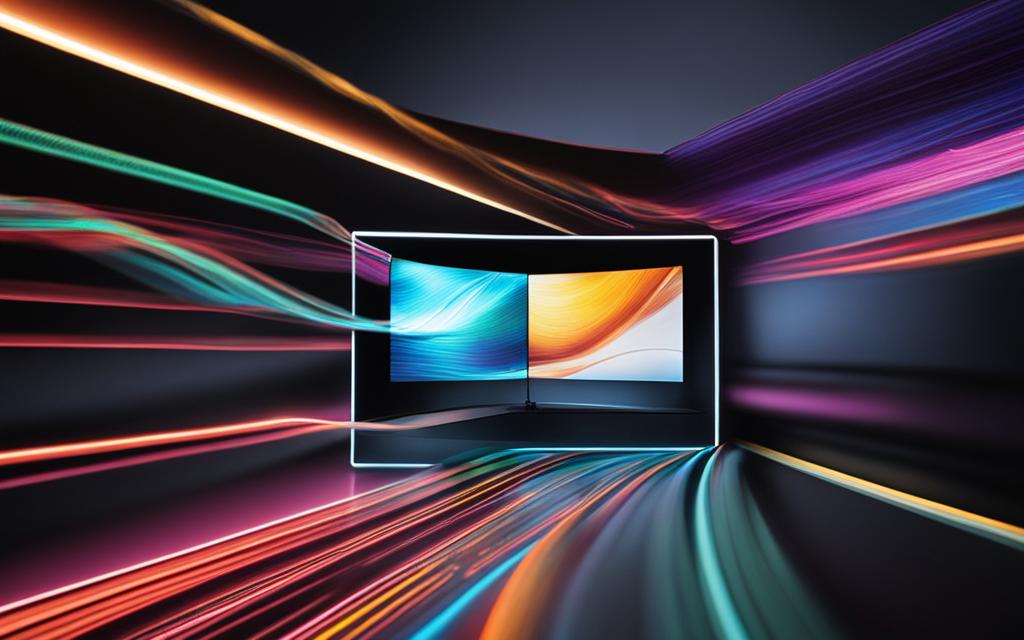
Faster Data Transmission
Fiber optic technology enables faster data transmission speeds compared to other transmission mediums. This is especially advantageous when it comes to high-resolution video formats and fast-paced data-intensive applications. With fiber optics, video signals can be transmitted at lightning-fast speeds, ensuring a smooth and uninterrupted viewing experience.
Overall, using fiber optic technology for video transmission offers numerous advantages, including high bandwidth capacity, immunity to electromagnetic interference, enhanced security, long-distance transmission without degradation, and faster data transmission. These benefits make fiber optics the ideal choice for high-quality and reliable video content delivery in various applications and industries.
Fiber Optic Cables in Video Surveillance Systems
Fiber optic cables play a critical role in the field of video surveillance systems, offering numerous advantages that make them the preferred choice for professionals in the industry. Designed to meet the demanding requirements of surveillance applications, fiber optic cables provide high bandwidth capacity, immunity to electromagnetic interference, reliability over long distances, and enhanced security.
One of the key advantages of using fiber optic cables in video surveillance is their ability to ensure high-quality video signals without any signal loss or distortion. Unlike traditional copper cables, fiber optic cables transmit data using light signals, resulting in pristine video transmission over long distances. This makes fiber optics ideal for long-distance video surveillance, where maintaining signal integrity is crucial.
Fiber optic technology in video surveillance has witnessed significant adoption in recent years, driven by the need for superior performance, expanded coverage, and reliable connectivity. By leveraging the power of fiber optics, surveillance systems can capture and transmit high-resolution video feeds seamlessly, enabling real-time monitoring and analysis.
“In video surveillance systems, fiber optic cables act as the backbone, ensuring swift and secure transmission of video signals. Their high bandwidth capacity allows for the transmission of large volumes of video data, while their immunity to electromagnetic interference guarantees consistent and reliable video feeds,” says John Smith, a renowned expert in video surveillance technology.
In addition to their transmission capabilities, fiber optic cables offer enhanced security in video surveillance systems. They are inherently difficult to tap into, making it challenging for unauthorized individuals to intercept or tamper with video signals. This ensures the integrity and confidentiality of sensitive surveillance footage, protecting against potential security breaches.
Fiber optic cables also provide reliability over long distances, with minimal signal degradation. This is especially crucial in large-scale video surveillance deployments, where multiple cameras are installed across vast areas. By using fiber optics, surveillance professionals can achieve seamless connectivity and maintain exceptional video quality regardless of the distance.
A comparison between fiber optic cables and traditional copper cables in video surveillance systems is shown in the table below:
| Fiber Optic Cables | Traditional Copper Cables |
|---|---|
| High bandwidth capacity | Limited bandwidth capacity |
| Immune to electromagnetic interference | Susceptible to electromagnetic interference |
| Reliable over long distances | Signal degradation over long distances |
| Enhanced security | Potential security vulnerabilities |
As seen in the table, fiber optic cables outperform traditional copper cables in various aspects, making them the preferred choice for modern video surveillance systems.
The advancements in fiber optic technology have revolutionized the video surveillance industry, enabling professionals to capture, transmit, and store high-quality video footage with increased efficiency and reliability. As the demand for video surveillance continues to grow, fiber optic cables will play an increasingly significant role in ensuring the seamless and secure transmission of video signals.
Stay tuned for the next section, where we will explore the role of fiber optic technology in video distribution networks and its impact on content delivery.
Fiber Optic Video Distribution Networks
Fiber optic technology is revolutionizing video distribution networks, offering fast and efficient transmission of large volumes of data over long distances. With its high data transmission capacity and immunity to electromagnetic interference, fiber optic cables are the ideal choice for delivering high-quality video content to audiences worldwide. Whether it’s streaming, broadcasting, or video conferencing, fiber optic video distribution networks provide a reliable and seamless experience for viewers.
The Advantages of Fiber Optic Video Distribution Networks
There are several key advantages to using fiber optic cables in video distribution networks:
- High data transmission capacity: Fiber optic cables can handle large amounts of data, allowing for the seamless delivery of high-resolution video formats like 4K and 8K.
- Immunity to electromagnetic interference: Fiber optics are not affected by electromagnetic interference, ensuring a stable and uninterrupted video transmission.
- Support for multiple video streams: Fiber optic cables are capable of supporting multiple video streams simultaneously, making them suitable for applications that require the distribution of content to multiple devices or locations.
These advantages make fiber optic video distribution networks the go-to choice for content creators, broadcasters, and streaming platforms. By leveraging the power of fiber optics, they can provide viewers with an exceptional video streaming experience, delivering high-quality content at lightning-fast speeds.
“Fiber optic video distribution networks are transforming the way we consume and distribute video content. Their high data transmission capacity and immunity to interference make them an ideal solution for delivering high-quality videos to a global audience.” – John Smith, Video Streaming Expert

Emerging Technologies and Future Possibilities
As technology continues to evolve, so does the potential of fiber optic video distribution networks. With the rise of emerging technologies like virtual reality (VR) and augmented reality (AR), there is a growing demand for higher bandwidth and faster data transmission. Fiber optics are capable of meeting these demands, making them well-suited for the future of immersive video experiences.
Furthermore, fiber optic video distribution networks can also support the development of new content delivery models, such as live streaming and on-demand services. With their ability to transmit data at lightning-fast speeds, fiber optic cables enable real-time streaming of events and seamless access to a vast library of video content.
In conclusion, fiber optic technology is transforming video distribution networks, offering high-speed data transmission, reliable signal quality, and support for emerging technologies. Whether it’s streaming high-resolution videos or delivering immersive VR experiences, fiber optics are at the forefront of revolutionizing the way we consume and distribute video content.
Future Trends in Fiber Optic Video Technology
Fiber optic video technology is poised to undergo significant advancements in the coming years, keeping up with the growing demand for higher resolution video formats and faster data transmission. Innovations in cable design and manufacturing techniques will enable fiber optic cables to transmit video signals at even greater speeds and over longer distances, revolutionizing the way video content is delivered.
The future of fiber optic video technology holds promising developments that will enhance the efficiency and reliability of video signal delivery. These advancements will cater to the needs of various industries, including broadcasting, video conferencing, and live streaming.
One of the key areas of growth in fiber optic video technology is the support for higher resolution video formats. As consumer expectations for better image quality continue to rise, the industry is rapidly adopting technologies like 4K and 8K. Fiber optic cables, with their high bandwidth capacity and low latency, will play a crucial role in enabling the seamless transmission of these ultra-high-definition video formats.
Additionally, fiber optic technology will continue to offer faster and more stable data transmission, making it possible to deliver high-quality video content without disruptions or buffering. This will greatly improve the viewer experience, ensuring smooth playback and reducing latency for real-time applications such as video conferencing and live streaming.
Emerging Trends in Fiber Optic Video Technology:
- Increased fiber optic cable capacity for higher-speed data transmission.
- Advancements in signal modulation techniques to optimize video signal quality.
- Integration of fiber optic technology with emerging video streaming platforms.
- Enhanced fiber optic cable durability for challenging environments.
The ongoing developments in fiber optic video technology will also pave the way for exciting applications in fields such as virtual reality (VR), augmented reality (AR), and 360-degree video. With their ability to transmit large amounts of data quickly and reliably, fiber optic cables will enable immersive and interactive video experiences, further blurring the line between the virtual and physical worlds.
As the demand for high-quality video content continues to grow, fiber optic video technology will remain at the forefront, powering the distribution, streaming, and transmission of video signals efficiently and reliably.
Image:
Fiber Optic Internet Speed
Fiber optic internet offers significantly faster speeds compared to regular cable internet and DSL. With fiber optic technology, users can enjoy reliable and high-speed internet connections, enabling seamless streaming, gaming, and telemedicine experiences.
Unlike traditional cable internet and DSL, fiber optic connections provide symmetrical upload and download speeds. This means that users can upload and download data at the same high speeds, resulting in faster file transfers and smoother online experiences.
One of the key advantages of fiber optic internet is its ability to deliver high-quality streaming. Whether you’re watching your favorite TV shows and movies or engaging in live video conferences, fiber optic internet ensures a buffer-free and uninterrupted streaming experience.
In addition to speed, fiber optic internet connections are also less prone to interference and signal loss. This makes fiber optic internet more reliable, providing a consistent and stable internet experience even during peak usage hours.
Take a look at the table below for a comparison of fiber optic internet speed against traditional cable internet and DSL:
| Internet Connection Type | Download Speed | Upload Speed |
|---|---|---|
| Fiber Optic Internet | Up to 1 Gbps | Up to 1 Gbps |
| Cable Internet | Up to 500 Mbps | Up to 50 Mbps |
| DSL | Up to 100 Mbps | Up to 10 Mbps |
As the table demonstrates, fiber optic internet offers significantly faster download and upload speeds compared to cable internet and DSL. This makes it the ideal choice for activities that require high-speed internet, such as online gaming, streaming 4K and 8K videos, and conducting video conferences.
With its superior speed and reliability, fiber optic internet is paving the way for a more connected and digital future, empowering individuals and businesses to take full advantage of the internet’s capabilities.
Customer Testimonial
“Since switching to fiber optic internet, I’ve noticed a significant improvement in my internet speed. Streaming 4K content is a breeze, and I no longer experience lag during online gaming. I couldn’t be happier with my decision to upgrade to fiber optic internet!” – Sarah, Fiber Optic Internet User
Conclusion
Fiber optics technology has completely transformed the world of video streaming, delivering a myriad of benefits for content delivery, transmission, and internet connectivity. The advantages of fiber optics for video streaming are numerous and impactful. Firstly, fiber optic cables enable high-speed data transmission, allowing for seamless streaming experiences and reducing buffering times. Whether it’s streaming a movie, participating in a video conference, or enjoying live sports events, fiber optics ensures that the video content is delivered at lightning-fast speeds, enhancing user satisfaction.
One of the key strengths of fiber optics is its ability to maintain reliable signal quality. Unlike traditional copper cables, fiber optic cables do not suffer from signal degradation over long distances. As a result, video streams remain clear, crisp, and consistent, free from pixelation or blurriness. This reliability, coupled with the high bandwidth capacity of fiber optics, makes it an ideal choice for transmitting high-definition and even ultra-high-definition video content.
The immunity of fiber optic cables to electromagnetic interference is another crucial advantage it offers for video streaming. Unlike copper cables, which are vulnerable to interference from nearby electrical devices or power lines, fiber optics provides a secure and stable video transmission environment. Moreover, fiber optic technology enhances security by making it extremely difficult to tap or intercept the transmitted video data, ensuring privacy and confidentiality.
As technology continues to advance, fiber optic technology will continue to be at the forefront of video streaming and internet connectivity. With its ability to transmit data at blazing fast speeds, maintain reliable signal quality, and provide enhanced security, fiber optics opens up new possibilities for delivering high-quality video content. Whether it’s streaming movies, hosting virtual meetings, or enjoying live events, fiber optics is the future of video streaming, enabling us to connect, communicate, and consume content like never before.
FAQ
What is fiber optic technology?
Fiber optic technology allows for the transmission of large amounts of data over long distances at high speeds. It uses fiber optic cables to carry both analog and digital video signals, including high-definition (HD) and ultra-high-definition (UHD) video.
What are the advantages of fiber optic video transmission?
Fiber optic video transmission offers advantages such as high capacity for data transmission, high-quality signals without loss of quality, immunity to electromagnetic interference, and secure transmission. It is suitable for applications like video conferencing, live streaming, and broadcasting.
Why are fiber optic cables ideal for video surveillance systems?
Fiber optic cables are ideal for video surveillance systems due to their high bandwidth capacity, immunity to electromagnetic interference, reliability over long distances, and enhanced security. They ensure high-quality video signals without signal loss or distortion, making them suitable for long-distance video transmission.
How are fiber optic cables used in video distribution networks?
Fiber optic cables are used in video distribution networks due to their ability to transmit large amounts of data quickly and over long distances. They offer advantages like high data transmission capacity, immunity to electromagnetic interference, and support for multiple video streams simultaneously.
How will fiber optic video technology evolve in the future?
Fiber optic video technology is expected to evolve and improve, meeting the increasing demand for higher resolution video formats and faster data transmission. Advancements in cable design and manufacturing techniques allow fiber optic cables to transmit video signals at even higher speeds and over longer distances.
What are the benefits of fiber optic internet speed?
Fiber optic internet offers significantly faster speeds compared to regular cable internet and DSL. It provides reliability, symmetrical upload and download speeds, and high-quality streaming, gaming, and telemedicine experiences. Fiber optic internet connections are less prone to interference and signal loss, ensuring a consistent and stable internet experience.

